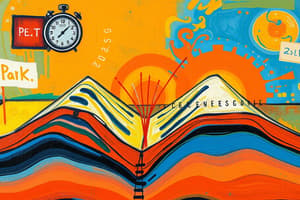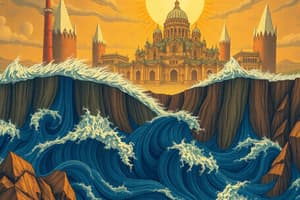Podcast
Questions and Answers
What primarily causes most earthquakes?
What primarily causes most earthquakes?
- Human activities like mining
- Meteorological changes
- Volcanic activity
- Tectonic plate movements (correct)
Which type of seismic wave arrives first at a seismograph?
Which type of seismic wave arrives first at a seismograph?
- S-waves
- P-waves (correct)
- Surface waves
- Rayleigh waves
What is the focus of an earthquake?
What is the focus of an earthquake?
- The center of a tectonic plate
- An area of weak rock prone to high seismic activity
- The point on the Earth's surface directly above the earthquake
- The point within the Earth where the earthquake originates (correct)
Which type of seismic wave typically causes the most damage?
Which type of seismic wave typically causes the most damage?
What depth range can the focus of an earthquake occur at?
What depth range can the focus of an earthquake occur at?
Which seismic wave can travel through both solids and liquids?
Which seismic wave can travel through both solids and liquids?
How does the amplitude of surface waves change with depth?
How does the amplitude of surface waves change with depth?
Which of the following human activities can induce earthquakes?
Which of the following human activities can induce earthquakes?
What is the primary function of a seismometer?
What is the primary function of a seismometer?
Which scale is considered more accurate for measuring an earthquake's magnitude?
Which scale is considered more accurate for measuring an earthquake's magnitude?
Which of the following describes the epicenter of an earthquake?
Which of the following describes the epicenter of an earthquake?
On the Modified Mercalli Intensity Scale, what does a level VIII signify?
On the Modified Mercalli Intensity Scale, what does a level VIII signify?
What geological feature is commonly associated with liquefaction during earthquakes?
What geological feature is commonly associated with liquefaction during earthquakes?
How are the geographical coordinates of the epicenter typically described?
How are the geographical coordinates of the epicenter typically described?
Which intensity level on the Modified Mercalli Intensity Scale corresponds to the description 'strong' shaking felt by most people indoors?
Which intensity level on the Modified Mercalli Intensity Scale corresponds to the description 'strong' shaking felt by most people indoors?
What typically happens at an intensity level of IX on the Modified Mercalli Intensity Scale?
What typically happens at an intensity level of IX on the Modified Mercalli Intensity Scale?
At which intensity level do heavy objects, like furniture, typically overturn or topple?
At which intensity level do heavy objects, like furniture, typically overturn or topple?
What does an intensity level of X on the Modified Mercalli Intensity Scale indicate?
What does an intensity level of X on the Modified Mercalli Intensity Scale indicate?
What is the common effect of a VI intensity level earthquake?
What is the common effect of a VI intensity level earthquake?
What type of earthquake intensity scale measures the intensity of shaking based on observable effects?
What type of earthquake intensity scale measures the intensity of shaking based on observable effects?
Which scale would likely yield a higher reading during a very strong earthquake, the Richter Scale or the Moment Magnitude Scale?
Which scale would likely yield a higher reading during a very strong earthquake, the Richter Scale or the Moment Magnitude Scale?
Which of the following earthquakes would most likely result in the strongest shaking reported at the epicenter?
Which of the following earthquakes would most likely result in the strongest shaking reported at the epicenter?
Flashcards
Earthquake
Earthquake
The shaking of the Earth's surface due to energy release in the lithosphere.
Tectonic Plate Movement
Tectonic Plate Movement
Main cause of most earthquakes; plates sliding along faults.
Seismic Waves
Seismic Waves
Waves of energy released during an earthquake.
P-waves
P-waves
Signup and view all the flashcards
S-waves
S-waves
Signup and view all the flashcards
Surface Waves
Surface Waves
Signup and view all the flashcards
Focus (Hypocenter)
Focus (Hypocenter)
Signup and view all the flashcards
Earthquake Depth
Earthquake Depth
Signup and view all the flashcards
Epicenter
Epicenter
Signup and view all the flashcards
Location of Epicenter
Location of Epicenter
Signup and view all the flashcards
Significance of Epicenter
Significance of Epicenter
Signup and view all the flashcards
Seismometer
Seismometer
Signup and view all the flashcards
Richter Scale
Richter Scale
Signup and view all the flashcards
Moment Magnitude Scale
Moment Magnitude Scale
Signup and view all the flashcards
Modified Mercalli Intensity Scale
Modified Mercalli Intensity Scale
Signup and view all the flashcards
Intensity Scale I
Intensity Scale I
Signup and view all the flashcards
Intensity Scale II
Intensity Scale II
Signup and view all the flashcards
Intensity Scale III
Intensity Scale III
Signup and view all the flashcards
Intensity Scale IV
Intensity Scale IV
Signup and view all the flashcards
Intensity Scale V
Intensity Scale V
Signup and view all the flashcards
Intensity Scale VI
Intensity Scale VI
Signup and view all the flashcards
Intensity Scale VII
Intensity Scale VII
Signup and view all the flashcards
Intensity Scale VIII
Intensity Scale VIII
Signup and view all the flashcards
Study Notes
Earthquakes
- Definition: An earthquake is the shaking of the Earth's surface, caused by sudden energy release in the lithosphere, producing seismic waves.
- Causes:
- Tectonic plate movements: Most earthquakes arise from fault movements along tectonic plates.
- Volcanic activity: Can trigger earthquakes.
- Human activities: Activities like mining, reservoir-induced seismicity, and fracking can induce earthquakes.
- Seismic Waves:
- P-waves (Primary waves): Compressional waves, travel fastest, pass through solids, liquids, and gases, arrive first on seismographs.
- S-waves (Secondary waves): Shear waves, slower than P-waves, travel only through solids.
- Surface waves: Travel along the Earth's surface, causing considerable damage.
- Love waves (L-waves): Horizontal motion, causing twisting, largest amplitude decreasing with depth, detected third, strong horizontal motion damages foundations.
- Rayleigh waves (R-waves): Rolling motion, both up-down and side-side, slower than Love waves, can occur on any surface, amplitude greater when originating from epicenter, detected by both seismograph mechanisms.
Focus (Hypocenter)
- Definition: The point within the Earth where an earthquake originates, the point at which stress is released in the rocks.
- Depth: Earthquakes can occur from a few kilometers to hundreds of kilometers below the surface.
- Significance: The depth of the focus affects how intense and what type of shaking is experienced at the surface; shallow foci often cause more serious surface shaking.
Studying That Suits You
Use AI to generate personalized quizzes and flashcards to suit your learning preferences.




